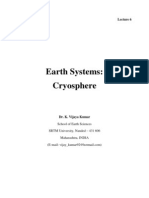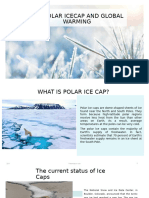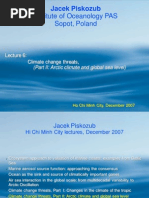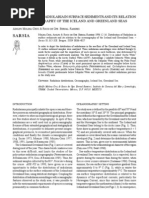Nasa Ice Poster
Nasa Ice Poster
Uploaded by
jdlawlisCopyright:
Available Formats
Nasa Ice Poster
Nasa Ice Poster
Uploaded by
jdlawlisCopyright
Available Formats
Share this document
Did you find this document useful?
Is this content inappropriate?
Copyright:
Available Formats
Nasa Ice Poster
Nasa Ice Poster
Uploaded by
jdlawlisCopyright:
Available Formats
National Aeronautics and Space Administration
Change in Elevation thinning no change thickening
Global Ice & Snow
ce and snow profoundly affect our climate. During the Northern Hemisphere winter, they blanket up to 16% of the Earths surface with a bright covering that reflects much of the Suns radiant energy back to space. During the Southern Hemisphere winter, they cover about half this area. An expected consequence of global warming is a decrease in the Earths snow and ice cover, which would increase the global absorption of solar radiation and, in the event of a significant melting of land ice, increase sea level. Satellite data provide the best means of monitoring the global ice coverage and its variability. Visible and infrared sensors provide high-resolution images under sunlit and cloud-free conditions, while microwave sensors provide observations under dark or light conditions and cloudy or cloud-free conditions, generally with less spatial detail.
Sept. 21, 1979
sia Rus
Sept. 16, 2007
Accurate measurements of the changes in the Greenland and Antarctic ice sheets are critical in quantifying forecasts for sea level rise. Since its launch in January 2003, the Ice, Cloud, and land Elevation Satellite (ICESat) has been measuring the change in elevation of these ice sheets. This image shows the changes in elevation of the Greenland ice sheet between 2003 and 2006. The white and yellow regions indicate a slight thickening, while the blue and purple shades indicate a thinning of the ice sheet.
Data from the Geoscience Laser Altimeter System (GLAS) on the ICESat satellite. Image credit: NASA Goddard Space Flight Center (GSFC)
Alaska
Greenland 5 km
Minimum, or near minimum, Arctic sea ice extent and concentration from 1979 and 2007. In 2007, the late summer ice extent was about 25% smaller and the late winter ice extent was about 6% smaller than the averages over the 28-year period. On average, ice at the summer minimum has been decreasing at a rate of about 9-10% per decade, with the annually averaged ice cover decreasing at the lesser rate of about 4-5% per decade. In contrast, Antarctic sea ice has increased.
Data for 1979 from the Scanning Multichannel Microwave Radiometer (SMMR) on NASAs Nimbus 7 satellite; data for 2007 from the Special Sensor Microwave Imager (SSMI) on a Defense Meteorological Satellite Program (DMSP) satellite
Ca
na da
Sea Ice Concentration (%) 0 15 100
Dronning Louise Land
Pine Island Glacier, western Antarctica, as seen on December 12, 2000 in the process of shedding an iceberg over 40 km long and 10 km wide. There is evidence that the Pine Island Glacier has been especially sensitive to increases in temperature where the ice meets the surrounding Amundsen Sea, showing thinning, increasing ice flow, and a rapidly retreating grounding line, where the ice meets the ground underneath. Sea ice cover in front of the glacier has been decreasing over the past few decades.
Data from the ASTER instrument on the Terra satellite, courtesy NASA/GSFC/METI/ERSDAC/JAROS and US/Japan ASTER Science Team
Greenland
April 2005
July 2005
sk Ala
Canada
ia ss Ru
sea ice
Kong O
scar F
jord
e Oc c i if Pac
October 2005
n so me d Ja Lan
Scoresby Sound 50 km
January 2006
The four globes to the left show seasonal snow cover over land for the Northern Hemisphere from April 2005 to January 2006 (note that sea ice and its snow cover are not shown). The various colors represent percentages of snow cover. The gray circle in October and January indicates no sunlight available; other instruments can make measurements in the absence of sunlight, but those measurements have a coarser spatial resolution. Continents are shown in dark gray.
Data from the Moderate Resolution imaging Spectroradiometer (MODIS) on the Terra and Aqua satellites
Eastern Greenland during the period of summer thaw, July 13, 2007.
Data from the Moderate Resolution Imaging Spectroradiometer (MODIS) on the Terra satellite
www.nasa.gov
Denma t rk Strai
eos.nasa.gov
National Aeronautics and Space Administration
Global Ice & Snow
ure water and moisture in the air freeze to form ice at 0C (32F), but seawater contains salt and other impurities that lower the temperature at which water freezes. One of the unusual properties of water is that when it freezes it increases in volumeand thus decreases in density. This property is a result of the very open structure of the water molecule when it freezes. It explains why ice floats on the surface of water, whether it is in a glass of iced tea or on the surface of lakes and seas. It also means that a body of water tends to freeze from the top down, which is important to the survival of marine ecosystems in areas subject to seasonal freezing. When the surface of the water freezes, this actually insulates the deeper layers from freezing, so that the aquatic life can survive the winter.
Glaciers: Harbingers of Change
Since measurements of the Jakobshavn Glacier were first taken in 1850, the glacier calving front has gradually receded until the 1960s, where it came to rest for nearly 40 years. Since 2000, however, the glacier front has been retreating again. In the six years between 2001 and 2006 it retreated approximately the same distance as in the preceding sixty. As this floating ice that has been wedged in the Jakobshavn channel retreated, the ice stream that feeds itone of the fastest in the worldresponded dramatically by doubling its speed to about 5 feet per hour. This kind of acceleration in response to retreating calving fronts is not unique to Jakobshavn glacier, and is important because it controls how much and how rapidly ice flows into the surrounding seas, contributing to sea level rise. The Jakobshavn Ice Stream is Greenlands largest outlet glacier, draining 6.5% of Greenlands ice sheet area. Its doubling of speed in the last few years has increased the rate of sea level rise by about .06 millimeters (about .002 inches) per year, or roughly 4% of the average 20th century rate of sea level increase.
10 km
Eastern Greenlands Summer Thaw
Summer thaw was underway in eastern Greenland when the data for this image were collected on July 13, 2007. Snow and ice inland (left) form a white blanket, while closer to the sea (to the right of the whitest areas) the annual snow has retreated from much of the rocky coastline and from the surfaces of some glaciers. In the fjords, meltwater carries finely ground sediment crushed by the movement of glaciers over rock. Sea ice (bottom center) has fractured into blocks, and small chunks of ice are scattered in some fjords like confetti. At far right, ice has disintegrated or been crushed into such small pieces that it looks like froth or foam swirling in the waters of the Greenland Sea. This image is centered on an area of Greenland located about midway along the islands eastern coastline. The section is bordered on the south by the Kangertittivaq, or Scoresby Sound. The sound is just north of 70 degrees north latitude. While the land around it appears barren and rocky, the north bank is actually vegetated. The grasses and low-growing tundra plants that survive there allow the area to support wildlife, including populations of mammals such as musk ox, lemmings, and Arctic foxes and hares, as well as land birds such as snow buntings, snowy owls, and Gyrfalcons.
Data from the Moderate Resolution Imaging Spectroradiometer (MODIS) on the Terra and Aqua satellites. Credit: NASA MODIS Rapid Response Team
Image data from the Landsat 7 satellite; the 2001-2006 calving fronts derived from the Landsat 7 and Terra satellites. Credit: NASA GSFC
sea ice
Trall
Kong O
scar F
jord
Sea Ice Change Impacts Life on the Ice
Earths polar regions are home to some 10-12 million people, both indigenous peoples and more recent immigrants. The survival and wellbeing of these people has always been closely linked to their understanding and adapting to their environment. Human beings have thrived in the midst of the harsh polar environment for millennia; but, although warming might reduce some of the harshness of the environment, the recent rapid rate of environmental change challenges even the resilient people of the Arctic. Scientific theory suggests that climate change tends to be particularly significant in the Earths polar regions, and residents of the Arctic are experiencing the effects. People living in the Arctic are witnessing climate change as the decades go by. Permafrostsoil frozen solid, some for thousands of yearsis beginning to melt rapidly; and the homes, businesses, and other infrastructure built on that sinking soil are threatened. Sea ice has also retreated and thinned substantially in recent decades, with the amount of permanent sea ice much less than it had been decades ago. Decreasing sea ice separates native peoples from the hunting grounds they have used to feed their families for generations. Moreover, the hunting grounds for polar bear, musk ox, and seal are no longer as reliable as they once were, and the length of the hunting season has decreased. The Arctic ecosystem has changed in response to warming. It is now not uncommon to hear the call of robins and other small birds, or the buzz of mosquitoes, or to see salmon splashing in Arctic waters. These are species that, prior to recent years, had not been seen in the Arctic for as long as anyone can remember. Warmer temperatures also affect species native to the Arctic. Polar bears are lethal hunters, stalking their prey while camouflaged against the bleak and barren Arctic landscape. But their hunting areas are disrupted as sea ice melts earlier in the season. This aspect can be favorable for baby seals, which are often prey for polar bears, but the baby seals have their own problems, as they can be malnourished because of insufficient time to fatten up before the ice melts and mother and baby are separated. The Antarctic has not experienced large sea ice decreases since the late 1970s like the Arctic has, but it has experienced changes, and these are affecting the Antarctic ecosystem, including the different penguin populations. Satellite remote sensing offers a unique vantage point for observing the polar environment and plays an important role in helping scientists understand the factors that drive environmental and social changes at high latitudes. At a time when humans are having an increasing effect on the planet, and when the human condition is increasingly affected by global changes, the polar regions are important and relevant for all of us to understand.
Image Credits: Elephant seal (Antarctica), Claire L. Parkinson; polar bear (Arctic), Robert Taylor; Emperor penguins (Antarctica), Josefino C. Comiso; portrait of Alaska Native Inupiat Eskimo, Clement Richards, taken by Lois Dalle-Molle
Denma t rk Strai
by es or d Sc Lan
Scoresby Sound 50 km sea ice
n so me d Ja Lan
Vanishing Ice?
Ice sheets and glaciers are important reservoirs for fresh water. Approximately 75% of the worlds fresh water is stored in ice, the remainder being stored underground or in lakes, rivers and streams. Of the 75% in ice, approximately 91% is held in the Antarctic ice sheet, 8% in the Greenland ice sheet, and the remaining 1% in mountain glaciers, which exist on every continent except Australia. Over the past century, sea level has slowly been rising. This is in part due to the expansion of ocean water as it warms and in part due to the addition of water to the oceans through either the melting or the calving off of icebergs from the worlds land ice. A vast majority of individual mountain glaciers and ice caps are known to have been retreating, some very rapidly, and their melt and consequent runoff contribute to sea level rise. Although scientific evidence is increasing that on balance, both the Greenland and Antarctic ice sheets are shrinking, it is still uncertain what impact this will have on the worlds population. If all the ice melted or otherwise entered into the oceans, global sea level would rise by approximately 70 meters. There is much ongoing research into exactly how both ice sheets are changing and how the mechanisms that control these changes worknot only measuring the elevation of the ice but also examining the outward flow of the ice and the mechanisms that might speed the flow of the ice into the oceans. Satellites are playing a crucial role in these studies, and when combined with observations from the field and from aircraft, as well as sophisticated models, scientists can develop a complete picture of how the ice is changing and why. Scientists use satellite altimeters such as the one on ICESat to measure changes in ice sheet elevation. ICESat has an instrument that fires laser pulses toward the Earths surface and very accurately measures the time it takes the light to travel from the satellite to the surface and back. Since scientists know how fast light travels in air, they can convert this time measurement into a distance measurement. Combining that measurement with the precise location of the satellite (determined by GPS), they can calculate the ice elevation. Scientists make these precise elevation measurements over the entire surface of the ice sheet for several years, which allows them to estimate the ice sheets volume change and its consequent contribution to sea level change.
Antarctica: The Land at the Bottom of the World
At the southernmost of the globe lies the coldest, windiest, and driest place on Earth: Antarctica. It is the seventh continent, with an area larger than the United States. It is the highest continent, the coldest continent, the windiest continent, and the brightest continent. All but about 2% of the 14 million-square-kilometer (5.4 million-square-mile) land surface is covered with ice; bare rock is only exposed in places along rocky coastlines and steep mountain slopes. In such a hostile environment, on-the-ground observations are scarce. Satellite data are invaluable for studying biological and physical processesincluding climate changeon and around Antarctica. Frigid, battered by hurricane-force winds, dark half of the year, and littered with steep mountains and deep crevasses that could swallow you whole, Antarctica is a place that would be much more comfortable to visit with a map than without one, and the more detailed and up-to-date the better. Of course, hostile conditions make thorough on-the-ground mapping dangerous, if not impossible. But thanks to NASA satellite data, scientists visiting or studying Antarctica after October 2005 will have available a significantly better map of the continents surface than they ever had before. Using data from the Moderate Resolution Imaging Spectroradiometer (MODIS) flying on NASAs Terra and Aqua satellites, researchers at the National Snow and Ice Data Center (NSIDC), at the University of Colorado and the University of New Hampshire, have assembled the most detailed map of Antarcticas snowy surface yet produced. Called the Mosaic of Antarctica (MOA), this map shows the continent in unprecedented detail. The MOA map includes all land areas south of 60 degrees South that are bigger than a few hundred metersin other words, all areas covered by the Antarctic Treaty.
Data for Antarctica was compiled from hundreds of images collected by the Moderate Resolution Imaging Spectroradiometer (MODIS) sensors on NASAs Terra and Aqua satellites. Image courtesy National Snow and Ice Data Center (NSIDC)
A Cycle of Sea Ice
February 2006 May 2006 August 2006 November 2006
Arctic
Antarctic
Seasonal cycle of Arctic and Antarctic sea ice coverage in 2006, as determined from satellite data. The maps show sea ice concentrations in February, May, August, and November. The continents are shown in black, oceans in dark gray. White indicates near total ice coverage and light gray less compact ice coverage. February is one of two months (the other being March) with the greatest sea ice coverage in the Arctic and is the month with the least ice coverage in the Antarctic. August is a late-summer month in the Arctic, just before the sea ice minimum in September; it is also a late-winter month in the Antarctic, with close to the annual maximum sea ice coverage.
Data from the Special Sensor Microwave Imager (SSMI) on the Defense Meteorological Satellite Program (DMSP). Image credit: NASA GFSC
Terra
Global Ice and Snow: A Mission Sampler
Landsat 7
Landsat 7 is the latest in a series of satellites that have provided calibrated Earth science data to both national and international users since 1972. Landsat 7 data have been used to monitor agricultural productivity, urban growth, and land-cover change, and are used widely for oil, gas, and mineral exploration. Other science applications include monitoring volcanoes, glacier dynamics, agricultural productivity, and coastal conditions. While other EOS instruments acquire frequent, coarse views of land-cover change, the higher spatial resolution of data from the Enhanced Thematic Mapper Plus (ETM+) instrument on Landsat 7 may help researchers to determine the actual causes of observed land-cover changes. These changes have important implications, both for local habitability and for the global cycling of carbon, nitrogen, and water.
The Terra mission, launched in December 1999, carries five instruments, three of which provide significant contributions to snow and ice studies. These are the Advanced Spaceborne Thermal Emission and Reflection Radiometer (ASTER), the Multi-angle Imaging SpectroRadiometer (MISR), and the Moderate Resolution Imaging Spectroradiometer (MODIS). The primary goal of ASTER is to gather data in 14 channels over targeted areas of the Earths surface, as well as black-and-white stereo images. ASTER provides the capability for repeat coverage of changing areas on the Earths surface with spatial resolutions of between 15 and 90 meters (49.2 and 295.2 feet) and augments the Landsat database, which was started in 1972. Together, the Landsat and ASTER data provide scientists with the ability to determine the rates that glaciers are advancing or receding. MISR measures the amount of sunlight that is scattered in different directions under natural conditions using nine cameras mounted at different angles. As the instrument flies overhead, each section of the Earths surface is successively imaged by all nine cameras in four wavelength bands. MODIS provides a comprehensive series of global observations every one or two days at spatial resolutions of up to 250 meters (820 feet). It provides the frequent observations necessary for multi-disciplinary studies of land, ocean and atmospheric interactions that enable us to understand more fully many of the critical issues affecting our environment. Among the variables being examined with MODIS data are glaciers, snow cover, and sea ice.
ICESat
Aqua
The Ice, Cloud, and land Elevation Satellite (ICESat) measures the height of the Earths polar ice masses, land and ocean surfaces, as well as clouds and aerosols in the atmosphere using advanced laser technology from a platform precisely controlled by star-trackers and the on-board Global Positioning System (GPS). ICESats Geoscience Laser Altimeter System (GLAS) instrument was developed at the Goddard Space Flight Center, as part of NASAs Earth Observing System, and was launched in January 2003. ICESat scientists are examining whether the great polar ice sheets are shrinking and how these ice masses may change under future climate conditions. ICESat is also helping us understand how clouds affect the heating and cooling of the Earth, is mapping vegetation heights, and should enable production of the most accurate maps of land topography. ICESat is designed to operate for 3-5 years and should be followed by successive missions to measure elevation changes for 15 years.
The Aqua mission, launched in May 2002, carries six instruments, two of which provide significant contributions to snow and ice studies. These are MODIS, also on Terra (see above), and the Advanced Microwave Scanning Radiometer for the Earth Observing System (AMSR-E). AMSR-E monitors global snow and ice covers and a variety of other climate variables. The microwave measurements allow surface observations under dark as well as sunlit conditions and under most cloud-covered as well as cloud-free conditions, providing an all-weather capability for surface observations that is not available with visible and infrared imagery. The instrument was contributed to the EOS program by the National Space Development Agency (NASDA) of Japan, now merged into the Japan Aerospace Exploration Agency (JAXA).
Jason
The instruments aboard Jason, a collaborative effort between NASA and the French Centre National dEtudes Spatiales, map ocean surface topography, providing information on ocean wave heights, wind speeds, and water vapor. Data collected by these instruments serve to advance our understanding of ocean circulation, and to improve our forecasting of climate events and the measurement of global sea-level change.
GRACE
DMSP
The Gravity Recovery and Climate Experiment (GRACE) is a joint US/German Earth-orbiting mission, launched from Plesetsk Cosmodrome in Russia on March 17, 2002. The missions two spacecraft fly in tandem to precisely measure Earths gravitational field and enable a better understanding of ocean surface currents, ocean heat transport, the Earths two remaining ice sheets, and other aspects of hydrology, oceanography, and solid-Earth sciences. Ocean currents transport mass and heat between different regions of the Earth, so that knowledge of these currents is vitally important for global climate studies.
The US Air Force has had responsibility for the Defense Meteorological Satellite Program (DMSP) since the mid-1960s. As a part of this program, they launched a series of spacecraft to investigate the Earths environment from an altitude of ~800 km. The satellites were all put into Sun-synchronous near-polar orbit with an inclination of ~99 degrees. Of particular interest to the polar research community are the later DMSP satellites, starting with DMSP 8, launched on June 20, 1987 with a passive-microwave instrument used in the monitoring of polar ice and snow.
www.nasa.gov
NW-2007-8-056-GSFC
eos.nasa.gov
You might also like
- Moment of Inertia of CoinDocument1 pageMoment of Inertia of Coinjdlawlis0% (1)
- Compendium 2009Document76 pagesCompendium 2009Thais MartinettiNo ratings yet
- Changing ClimateDocument2 pagesChanging ClimateAlondra IslasNo ratings yet
- Icy Arctic Final - 508Document12 pagesIcy Arctic Final - 508Kiran KumarNo ratings yet
- GlacierDocument20 pagesGlacierftehreem2001No ratings yet
- Antarctic Sea Ice Hit Record Lows AgainDocument2 pagesAntarctic Sea Ice Hit Record Lows AgainHenry AndersonNo ratings yet
- EnglishDocument19 pagesEnglishakshatdas08No ratings yet
- Polar Ice CapDocument4 pagesPolar Ice CapZoth BernsteinNo ratings yet
- Why Sea Ice Matters National Snow and Ice Data CenterDocument1 pageWhy Sea Ice Matters National Snow and Ice Data Centerhoanghai090112No ratings yet
- Global Response To Melting Glaciers and Ice SheetsDocument12 pagesGlobal Response To Melting Glaciers and Ice SheetsnikitaNo ratings yet
- Lec 1 Cryosphere IntroductionDocument35 pagesLec 1 Cryosphere IntroductionArhat GedamNo ratings yet
- Class 12 English Project Prathamesh Ramesh JadhavDocument23 pagesClass 12 English Project Prathamesh Ramesh JadhavPrathamesh JadhavNo ratings yet
- Geoinformatics 2007 Vol04Document45 pagesGeoinformatics 2007 Vol04protogeografoNo ratings yet
- Comprehensive Book On Glaciology, A (Helm, Nakita)Document111 pagesComprehensive Book On Glaciology, A (Helm, Nakita)obtainableunobtainiumNo ratings yet
- Extraordinary Thinning' of Ice Sheets Revealed Deep Inside AntarcticaDocument2 pagesExtraordinary Thinning' of Ice Sheets Revealed Deep Inside AntarcticaЕлизавета ЧерноваNo ratings yet
- Molar Polar IceDocument24 pagesMolar Polar IceJENNIFERNo ratings yet
- Geo Lecture9 PDFDocument46 pagesGeo Lecture9 PDFKASSANDRA DENISE DIMAAPINo ratings yet
- Reaction PaperDocument1 pageReaction PaperJustine Kei Lim-OrtegaNo ratings yet
- Glaciers Notes Part 1Document6 pagesGlaciers Notes Part 1David ZhaoNo ratings yet
- Lecture - Ice - Shelf - Berg March 17 and 20Document43 pagesLecture - Ice - Shelf - Berg March 17 and 20uzear00No ratings yet
- alaska _)Document10 pagesalaska _)sukritinayak1205No ratings yet
- GlaciersDocument58 pagesGlaciersapi-3706215100% (3)
- Present and Future Climate of AntarcticaDocument19 pagesPresent and Future Climate of AntarcticaManish SinghNo ratings yet
- Past Present and Future Climate of AntarcticaDocument19 pagesPast Present and Future Climate of AntarcticameNo ratings yet
- Global ChangesDocument4 pagesGlobal ChangesnicoloNo ratings yet
- Ice - Age - Spring 2024Document42 pagesIce - Age - Spring 2024Chandreyee ChakrabortyNo ratings yet
- Geophysical - Research - Letters JaponDocument9 pagesGeophysical - Research - Letters Japonesteban polarisNo ratings yet
- Everyone Should Be Concerned' - Antarctic Sea Ice Reaches LowestDocument13 pagesEveryone Should Be Concerned' - Antarctic Sea Ice Reaches LowestEkkoNo ratings yet
- Present and Future Climate of Antarctica (1)Document19 pagesPresent and Future Climate of Antarctica (1)sahusahanajs18No ratings yet
- Polar IceDocument4 pagesPolar IceMohamed RashidNo ratings yet
- Artic Geography SummaryDocument14 pagesArtic Geography SummarymarthimarinoNo ratings yet
- Report 6: GlaciersDocument2 pagesReport 6: Glaciers79haydenNo ratings yet
- Glacier Course MIT Earthsurface 7Document81 pagesGlacier Course MIT Earthsurface 7Iván Cáceres AnguloNo ratings yet
- Earth Systems: Cryosphere: School of Earth Sciences SRTM University, Nanded - 431 606 Maharashtra, INDIADocument12 pagesEarth Systems: Cryosphere: School of Earth Sciences SRTM University, Nanded - 431 606 Maharashtra, INDIAMangam RajkumarNo ratings yet
- Hashim Kababji-Ayra Adil-Omar El Chaarani - Ice SheetsDocument7 pagesHashim Kababji-Ayra Adil-Omar El Chaarani - Ice SheetsA ANo ratings yet
- J. 2019 Bowditch - Volume 1 - Part 8 Ice and Polar Navigation Chapter 32-33Document57 pagesJ. 2019 Bowditch - Volume 1 - Part 8 Ice and Polar Navigation Chapter 32-33Sydney HansonNo ratings yet
- Ice BergDocument2 pagesIce BergFahimaNo ratings yet
- The Polar Icecap and Global WarmingDocument8 pagesThe Polar Icecap and Global WarmingKritika VatsNo ratings yet
- CryosphereDocument20 pagesCryosphereJG MercadoNo ratings yet
- Intermediate Unit 10 DVD Script: DA David AttenboroughDocument1 pageIntermediate Unit 10 DVD Script: DA David AttenboroughbobNo ratings yet
- Vietnam Lecture6 PolarDocument65 pagesVietnam Lecture6 PolartiktiktakNo ratings yet
- Big TiltDocument17 pagesBig TiltRichard HazingtonNo ratings yet
- Cest2015 01430 Poster Paper 2Document7 pagesCest2015 01430 Poster Paper 2aemilianneNo ratings yet
- Report On Global Warming and Its Effect On GlaciersDocument6 pagesReport On Global Warming and Its Effect On GlaciersmitudevilNo ratings yet
- A Study - : by Capt. Francis T. GauciDocument145 pagesA Study - : by Capt. Francis T. GauciCarmen DarmaninNo ratings yet
- Greenland & Climate Change 2016Document6 pagesGreenland & Climate Change 2016Global Unification InternationalNo ratings yet
- Ice SheetsDocument19 pagesIce SheetslovleshrubyNo ratings yet
- Report On Global Warming and Its Effect On Glaciers: Some Consequences of Melting Glaciers WorldwideDocument6 pagesReport On Global Warming and Its Effect On Glaciers: Some Consequences of Melting Glaciers WorldwidemitudevilNo ratings yet
- Partido State University: Module 15: Effect of Last Ice Age in The World Glaciers FormationDocument6 pagesPartido State University: Module 15: Effect of Last Ice Age in The World Glaciers FormationRalph NavelinoNo ratings yet
- Cryo SphereDocument59 pagesCryo SphereGedy YunusNo ratings yet
- SarsiaDocument14 pagesSarsiakarimgohariNo ratings yet
- Glaciers of AntarcticaDocument5 pagesGlaciers of AntarcticaszsoomroNo ratings yet
- Permafrost - Weather UndergroundDocument7 pagesPermafrost - Weather Undergroundsharper#No ratings yet
- Air Bone RadarDocument29 pagesAir Bone RadarsusasureshNo ratings yet
- Interesting Facts About Glaciers - Geology for Beginners | Children's Geology BooksFrom EverandInteresting Facts About Glaciers - Geology for Beginners | Children's Geology BooksNo ratings yet
- Nysa PaulDocument30 pagesNysa Pauljassi nishadNo ratings yet
- Decline of Arctic Sea Ice - Six Ways Loss of Frozen Seawater Could Affect HumansDocument3 pagesDecline of Arctic Sea Ice - Six Ways Loss of Frozen Seawater Could Affect HumansCONELISA NAVALESNo ratings yet
- Backgrounder - Climate Driven Thaw of Permafrost PDFDocument3 pagesBackgrounder - Climate Driven Thaw of Permafrost PDFnikenNo ratings yet
- Index: Increasing Effect of Temperature in Your NeighbourhoodDocument18 pagesIndex: Increasing Effect of Temperature in Your Neighbourhoodjassi nishadNo ratings yet
- 9 Dorothy Sea Ice 2010Document13 pages9 Dorothy Sea Ice 2010waqas20No ratings yet
- OH-58D Kiowa Warrior DimensionsDocument1 pageOH-58D Kiowa Warrior DimensionsjdlawlisNo ratings yet
- Phottix TC-501 ManualDocument1 pagePhottix TC-501 ManualjdlawlisNo ratings yet
- Gravity PresentationDocument10 pagesGravity PresentationjdlawlisNo ratings yet
- Vectors: C B A BDocument15 pagesVectors: C B A BjdlawlisNo ratings yet
- Given A Potential Energy Graph, Oscillations Will Occur Between Turning Points Determined byDocument9 pagesGiven A Potential Energy Graph, Oscillations Will Occur Between Turning Points Determined byjdlawlisNo ratings yet
- Cauliflower With Fennel and Mustard SeedsDocument1 pageCauliflower With Fennel and Mustard SeedsjdlawlisNo ratings yet
- Atomic Radii Scale and Related Size Properties From Density Functional Electronegativity FormulationDocument5 pagesAtomic Radii Scale and Related Size Properties From Density Functional Electronegativity FormulationjdlawlisNo ratings yet
- Aww June 2014Document76 pagesAww June 2014sri9987No ratings yet
- EGM2008 PipDocument141 pagesEGM2008 PipMarŷ FerNo ratings yet
- Ground Water in EgyptDocument26 pagesGround Water in EgyptHassanKMNo ratings yet
- Remote Sensing ApplicationsDocument31 pagesRemote Sensing ApplicationsRamanarayanSankritiNo ratings yet
- M8L7Document31 pagesM8L7RamanarayanSankritiNo ratings yet
- Anticipated Sea-Level Rise Coastal Louisiana Technical Report Version 1.4Document121 pagesAnticipated Sea-Level Rise Coastal Louisiana Technical Report Version 1.4PaleogeneNo ratings yet
- Remote Sensing of African Lakes: A ReviewDocument20 pagesRemote Sensing of African Lakes: A Reviewmiss mdNo ratings yet
- Nature - 2018 05 31Document376 pagesNature - 2018 05 31elektrenaiNo ratings yet
- Studying The Earth's Gravity From Space: The Gravity Recovery and Climate Experiment (GRACE)Document6 pagesStudying The Earth's Gravity From Space: The Gravity Recovery and Climate Experiment (GRACE)RazzakRaffiuLanataNo ratings yet
- EETimes EuropeDocument52 pagesEETimes EuropeIbrahim Al-TaieNo ratings yet
- Modul-1:: Introduction To Satellite GeodesyDocument79 pagesModul-1:: Introduction To Satellite GeodesyYusuf MustajabNo ratings yet
- Tsunmi Scrap BookDocument31 pagesTsunmi Scrap Bookharvinder thukralNo ratings yet
- GravityDocument72 pagesGravityفردوس سليمانNo ratings yet

















































































